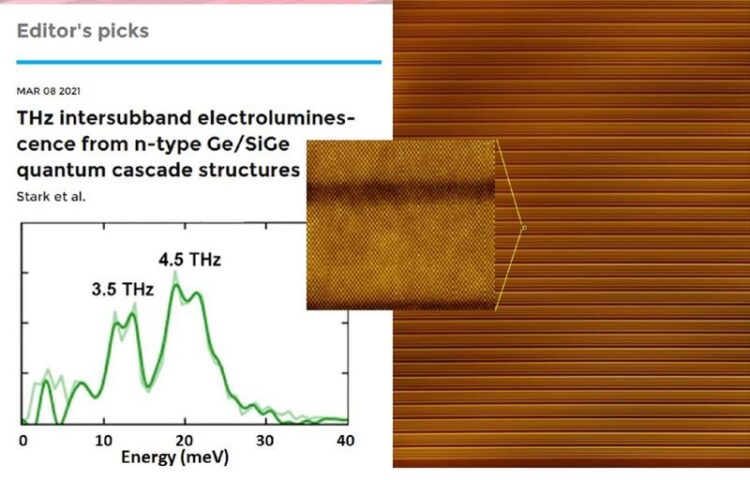Light from silicon

Left:the light intensity emitted in the THz region;Right:an electron micro-scopy of the alternating layer struc-ture of Ge and SiGe alloy at the base of the device;Center:The atomic accuracy of the various layers can be observed in the magnification shown
Editor’s Picks, Appl. Phys. Lett. 118, 101101 (2021); https://doi.org/10.1063/5.0041327
The demonstration of electroluminescence at terahertz frequencies from a silicon and germanium-based device represents a significant step towards the coveted milestone of a silicon-based laser.
An international team comprising scientists from Leibniz Institute for High Performance Microelectronics (IHP) has demonstrated for the first time THz light emission from n-type quantum structures made of germanium and silicon, the materials that are the basis of most commonly used electronic devices.
The result of demonstration was published in the Applied Physics Letters in the March 8 issue (D. Stark et al. “THz intersubband electroluminescence from n-type Ge/SiGe quantum cascade structures”, Applied Physics Letters 118, 101101 (2021), https://doi.org/10.1063/5.0041327), and was selected as “Editor’s pick” by the editorial board of the important international journal. “This result represents the first credible step towards the realization of a new type of quantum cascade laser (QCL) for THz light emission, that could be entirely manufactured and which could be achieved at low cost using the manufacturing processes of common microelectronic devices,” says Prof. Monica De Seta of the Science Department of Università Roma Tre, who coordinates the consortium of the European project FLASH (Horizon 2020 FET-Open project FLASH (G.A. 766719) https://www.flash-project.eu/). The FLASH consortium includes also the Zurich Polytechnic ETH (CH), the University of Glasgow (UK), the start-up NextNano of Munich (D), with the contribution of researchers from the La Sapienza University of Rome and University of Pisa (Ita).
THz light energy is between that of microwaves and infrared, and has peculiar characteristics, such as the ability to penetrate through many materials that are opaque in the visible range, such as paper and fabrics, is not ionizing and therefore do not damage living matter. Furthermore, the fact that many biological molecules and chemical compounds underlying complex materials such as explosives and drugs possess unique “fingerprints” in this spectral range, makes THz light extremely interesting from an application point of view.
“This important result has been made possible by the progress we have made in the ability to control the deposition of the quantum superstructures underlying the device. In practice, it was necessary to alternate hundreds of layers of different chemical composition, only a few billionths of a meter thick, with control at the level of the single atomic layer. Furthermore, we were able to reduce the defects that naturally forms in such thick structures. Both this achievements are crucial in obtaining the quantum cascade conditions that are necessary for the THz emission in our light emitting device “notes Prof. Giovanni Capellini, responsible for the materials characterization and leading the FLASH project at IHP.
The QCL device targeted by the FLASH consortium could represent a turning point in the use of THz technology on a large scale in various strategic sectors such as medical diagnostics, airport scanners, and in quality monitoring in industrial production. All these applications are in fact limited especially by the absence of compact and inexpensive THz light emitters.
Wissenschaftliche Ansprechpartner:
Prof. Giovanni Capellini
Media Contact
All latest news from the category: Power and Electrical Engineering
This topic covers issues related to energy generation, conversion, transportation and consumption and how the industry is addressing the challenge of energy efficiency in general.
innovations-report provides in-depth and informative reports and articles on subjects ranging from wind energy, fuel cell technology, solar energy, geothermal energy, petroleum, gas, nuclear engineering, alternative energy and energy efficiency to fusion, hydrogen and superconductor technologies.
Newest articles

Parallel Paths: Understanding Malaria Resistance in Chimpanzees and Humans
The closest relatives of humans adapt genetically to habitats and infections Survival of the Fittest: Genetic Adaptations Uncovered in Chimpanzees Görlitz, 10.01.2025. Chimpanzees have genetic adaptations that help them survive…

You are What You Eat—Stanford Study Links Fiber to Anti-Cancer Gene Modulation
The Fiber Gap: A Growing Concern in American Diets Fiber is well known to be an important part of a healthy diet, yet less than 10% of Americans eat the minimum recommended…

Trust Your Gut—RNA-Protein Discovery for Better Immunity
HIRI researchers uncover control mechanisms of polysaccharide utilization in Bacteroides thetaiotaomicron. Researchers at the Helmholtz Institute for RNA-based Infection Research (HIRI) and the Julius-Maximilians-Universität (JMU) in Würzburg have identified a…



